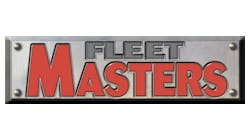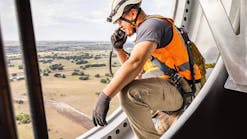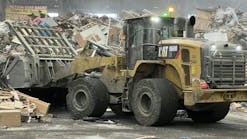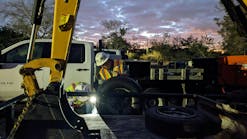He has no shortage of advice for managers on what makes a successful shop. One of the biggest priorities, Schlangen says, should be organization through establishing clear goals, starting with a preventive maintenance plan.
Dakota County is the medium-fleet winner of the 2017 Fleet Masters Award.
“Make sure that you have a good and established preventative maintenance program,” Schlangen says. “For a well-run shop, you need to have a PM program in place and...have the training, the check sheets, and the understanding of what all the technicians are going to do in the shop. The backbone of keeping your costs down in any kind of fleet operation is your PM program.
“I hear people say, ‘I don’t have time to get my PM program off the ground.’ If you don’t enforce that and have a program in place, you will never dig out of the hole you created, and you’ll spend your entire time putting out fires and being reactionary,” Schlangen says.
Schlangen recommends managers start slow, realizing there are many different types of equipment categories begging for procedures. “It’s tough to say you’re going to have a check sheet for everything in your fleet,” he says. “It literally takes years for you to get to that point. You’ve got to pick what’s going to have the best impact for you. What are the worst offenders, the higher-cost vehicles and equipment in your fleet? Tackle those first—the problem children—the ones that can’t perform the duties needed.”
Tracking is also a key component.
“If you don’t track it, you don’t know if you’re improving,” Schlangen says. “If you don’t put the time into deciding what you want for a fleet information system—and there are so many good systems out there—you have to find what is the best fit for your organization and you have to start tracking that information. You track things so that you actually know if any of your programs or what you’re implementing are making a difference, or if you’re just spinning your wheels.”
Concurrent with organization and tracking is ensuring that techs have the proper equipment. Schlangen is a big proponent of providing tools for technicians.
“This is an important part of safety and making sure they have what is necessary,” Schlangen says. “A person who reports to work in an office environment doesn’t bring their own computer, printer, or paper, so why do so many organizations feel that the tech has to bring all their tools? By supplying standard sets of tools, you’re ensuring your techs have what is necessary for them to maintain the equipment that you have.
“Sometimes they want tools and equipment that is not necessary, and other times they may not have what they need because they can’t afford it,” Schlangen says.
“If you only give them an allowance, how are they supposed to have the right tools to safely be within your shop? By supplying them, you also gain more control over being able to inspect the tools regularly to make sure the expectations are met.”
In the video below, Schlangen shares some tips for setting up a well-run shop.
Schlangen recommends assigning tools to technicians and emphasizing the need to keep them, and the shop, clean.
“A clean shop is a safe shop,” Schlangen says. “If you’re not keeping it organized and inspected, every last dirty part that you replaced is on the floor for somebody to trip over.
“You should be keeping your shop clean enough that [visitors] don’t know how old your shop is,” Schlangen says. “People should say, ‘Wow, I can’t believe this is a 20-year-old shop.’ It reflects on all your staff, and everyone steps up and keeps it [clean]. Because once a mess starts, it just snowballs.”
Schlangen recommends buying a floor sweeper (see below). “Don’t make [techs] go around and push a broom to clean their bays. We invest money on job sites to make something more efficient, but then we cheap out when we come to the shop area. What’s wrong with purchasing a ride-on floor sweeper to actually sweep the bays when you back something out? It takes a very small amount of time to run over it and keep it clean. You can’t expect it to happen without an effort and some money being invested in it.”
Another key area is parts stocking. Tracking information is again necessary to know what parts to have on hand.
“Track the repairs you’ve gone through,” Schlangen says. “How many tires or different brake components are you going through? Do you have seasonal stuff in place? Without a good fleet information system to track where you’re at, you can’t make these [parts] decisions.”
Schlangen hesitates to put a cost number on parts inventory. “Saying it should be X percent of what you spend in a given year, I hesitate to give those types of recommendations to anyone because you have to know your organization. To come into a place like we’re at and say that, in snow removal, why on earth do you have that many cutting edges on hand? It’s because [we know] nobody else stocks it, or, how am I supposed to get that part on Christmas Day? How am I supposed to get those cutting edges when everybody in the world is now ordering them and now you don’t have any of them available anywhere?”
Knowledge and experience are key.
“If your organization knows that there’s a large project coming up and you’re going to be running every excavator you have and you’re going to need particular bucket teeth, you have to know these things are coming up ahead of time,” Schlangen says. “That will make a difference on how you stock going into those jobs that you have already acquired as opposed to the ones you’re bidding on. That’s oil, fuel, every aspect fits into those categories.”
Schlangen advises managers to dedicate a full-time staffer to parts stocking and management but says that may be difficult based on an organization’s size.
He also advocates thorough technician training.
“If you’re not going to invest in your staff, you’re going to be so disappointed,” Schlangen says. “People say, ‘What if I train them and they leave?’ but ‘What if I don’t train them and they stay?’ What are you going to do then?”
Above: Fleet manager Kevin Schlangen, CEM, recommends purchasing a floor sweeper for the shop to quickly and efficiently clean bays and other areas, eliminating the need for techs to spend time pushing brooms.
Dakota County has chosen ASE certification and is a Blue Seal of Excellence shop. It expects techs to keep up on recertification every five years.
“As we hire new staff, we never take a new tech and just put them out on the floor,” Schlangen says. “They are always paired off and mentored, and not just by one person; they jump around, we keep assigning them so that they learn different jobs and different aspects. That way they get to know other techs, too, and instead of just being at work, doing their job and going home, they’re going to start forming those relationships with the people they work alongside every day.
“We also work as much as possible with vendors training our staff directly,” Schlangen says, offering an example. “We will have them come onsite and do a training session on our plow trucks on the hydraulic system: how to troubleshoot them, how to program, and how to hook up the laptops to do different programs.”
Schlangen also tries to send county tech staff to trade shows, using it as a reward. He says it is advantageous for them to attend educational sessions and mix with other techs. Forging connections in the industry and meeting different types of people is also good training for learning how to interact with customers.
“And a lot of times they can come back with a little greater appreciation for how good they may have it as opposed to listening to what somebody else’s work environment may look like, what their shop may look like, or what they have for tools and equipment,” Schlangen says.
He also hires trainees from local technical colleges, letting them work in the shop in between classes. “We’ve actually hired a few techs from there because we’ve been able to test drive them here and know what their mechanical aptitude is and what their attitude is— whether or not they’re going to be a good fit and a long-range good investment.”
New techs should also have a set of standard operational procedures to learn. “You should put together a manual that is touching on the basic things that need to be done: the inspection of the lifts that you have, your cranes, how you change your tires, how you air up a split-rim tire,” Schlangen says.
“That type of a manual goes a long way in training and safety for your staff. Whatever are the more commonly used tools within your shop, you should have SOPs for them, along with lockout/tagout procedures in place,” Schlangen says. “You also need to have flat rates in place. If they’re doing a brake job or service level at PM, you’d better have that stuff flat-rated so if it’s supposed to take 2 hours, somebody shouldn’t be spending 20 hours to do the same job.”
Finally, Schlangen stresses key performance indicators.
“For us at the county, these are the efficiency levels, what our costs are, and what does every piece of equipment we have actually cost us per mile or hour to run?” he says. “Is it more efficient for us to own it or not? All that ties into efficiencies in the shop. A poorly run shop means you’re not going to have the numbers that are needed for your company, organization, or municipality to make good business decisions.
“Tracking all those things is very important or you just lose efficiencies—you lose profit—whether you’re in the private or public sector,” Schlangen says. “We still consider this a business. And if you don’t run a shop like a business and expect it to make ends meet or at least break even, you have to have some reason to justify your existence and why somebody doesn’t go across the street to have somebody else do the repair rather than your own shop and staff.”







